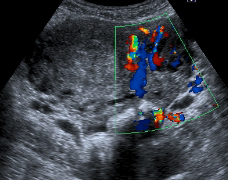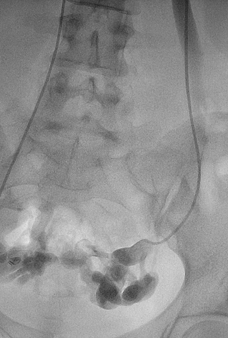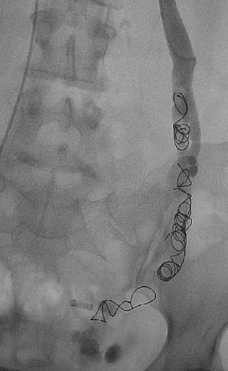Pelvic Congestion Syndrome
Pelvic Congestion Syndrome is a term describing symptoms related to pelvic varicose veins. These dilated veins are similar to varicose veins in the legs but occur deep in the pelvis, often due to incompetent valves higher up particularly in the ovarian veins (especially the left). The symptoms vary from a dull aching or dragging sensation which may be worse on standing for long periods or towards the end of the day to more severe discomfort, backache, painful intercourse and painful menstruation. Occasionally there may be associated visible varicose veins on the vulva or associated varicose veins of the thighs and buttocks.
Pelvic Congestion Syndrome (or ovarian vein syndrome as it has also been described) is probably a very much under-diagnosed condition and has in the past been a diagnosis made after other conditions have been excluded. It is more common in women who have had multiple pregnancies. Modern non-invasive imaging techniques such as ultrasound, MRI and CT scanning along with an increased awareness of the condition and its clinical features among gynaecologists means that many more women are now being diagnosed and treated.
Embolisation for Pelvic Congestion Syndrome
Dr. Crowe offers embolisation as a treatment for pelvic congestion syndrome. It will often be necessary to arrange a scan (ultrasound, CT or MRI) to confirm the diagnosis and if you have not had a recent clinical examination or are not currently under the care of a gynaecologist arrangements can be made for you to see Miss Shirin Irani, Consultant Gynaecologist, who works closely with Dr. Crowe to provide this service.
The treatment is performed as a day case procedure at the Priory Hospital under local anaesthetic and x-ray guidance. A tiny needle puncture is made into a vein in the groin and venography is performed by injecting dye to show the veins involved. The underlying problem is reflux (or flow going in the wrong direction) in the veins, possibly related to incompetence of valves. The most common source of reflux is the ovarian vein, expecially, the left. The offending vein is blocked off by placing metallic coils under x-ray guidance and the whole procedure only takes about 30 minutes followed by an hour or two of bed rest afterwards. You can go home later the same day, are back to normal activity virtually immediately and should notice symptomatic improvement within a few days. Occasionally in more complex cases a two stage or repeat procedure may be necessary.
Read Daily Mail article on pelvic congestion syndrome.
For further information or to make an appointment for an initial consultation please contact Dr. Crowe.




